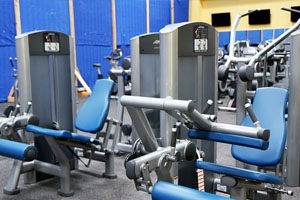Explore the world of fitness with our guide to anaerobic vs aerobic exercise Learn the differences, benefits, and how to choose the right workout for your health goals Get fit today!
What is the difference between anaerobic and aerobic exercise? This is a common question among individuals looking to enhance their fitness routines. Anaerobic and aerobic exercise are two distinct approaches to physical activity, each offering unique benefits and targeting specific aspects of your health and fitness. Whether you're striving to build muscle, improve cardiovascular health, or achieve weight loss, understanding the characteristics of these exercise forms is crucial. In this article, we will explore the fundamentals of anaerobic and aerobic exercises, their benefits, and how to determine which one aligns best with your fitness goals.

Understanding Anaerobic vs. Aerobic
Before diving into the details of anaerobic and aerobic exercises, it's essential to understand the fundamental differences between these two forms of physical activity. Anaerobic and aerobic exercises differ primarily in their energy systems, intensity, and the way they affect your body. Let's explore the distinctions:
Anaerobic Exercise
Understanding anaerobic exercise involves grasping the concept of intense, short bursts of physical activity that rely on energy sources other than oxygen. Anaerobic activities push your muscles to their limits, leading to increased strength, power, and muscle mass. These exercises include:
- Sprinting: Short, high-speed runs that engage fast-twitch muscle fibers.
- Weightlifting: Lifting heavy weights to build muscle and strength.
- High-Intensity Interval Training (HIIT): A series of intense exercises followed by short rest periods.
Aerobic Exercise
Aerobic exercise, on the other hand, relies on oxygen as the primary energy source. It involves continuous, rhythmic movements that elevate your heart rate and breathing. Aerobic activities contribute to improved cardiovascular health, endurance, and overall fitness. Common aerobic exercises include:
- Running: Steady-paced jogging or distance running that enhances endurance.
- Cycling: Riding a bicycle at a consistent pace to strengthen the heart and lungs.
- Swimming: A full-body workout that increases cardiovascular fitness.
Now that you have a basic understanding of anaerobic and aerobic exercises, it's time to delve deeper into the specifics of each category.
What is Anaerobic Exercise?
Anaerobic exercises are intense, short bursts of physical activity that rely on energy sources other than oxygen. Understanding the essence of anaerobic exercise is crucial to harness its benefits and tailor your fitness routine accordingly. Here, we delve into the specifics:
Energy Systems in Anaerobic Exercise
To comprehend anaerobic exercise, you need to grasp the energy systems that fuel these activities. Anaerobic exercises primarily tap into two key energy systems:
- ATP-PC System (Adenosine Triphosphate-Phosphocreatine System): This system provides rapid but short-lived energy bursts. It powers high-intensity activities like weightlifting and sprinting.
- Glycolytic System: Anaerobic exercises also rely on the glycolytic system, which utilizes stored glucose for energy. It supports activities such as HIIT workouts.
Key Characteristics of Anaerobic Exercise
Anaerobic exercises exhibit several distinguishing features:
- High Intensity: These exercises are characterized by their high-intensity nature, pushing your muscles to their limits.
- Short Duration: Anaerobic activities are typically short in duration, with each session lasting from a few seconds to a few minutes.
- Muscle Building: They promote muscle growth, strength, and power due to the stress they place on your muscles.
Now that you have a fundamental understanding of anaerobic exercise and its energy systems, let's explore specific anaerobic activities in more detail.
Benefits of Anaerobic Exercise
Engaging in anaerobic exercise offers a plethora of advantages that can significantly enhance your fitness journey. Let's explore these benefits in detail:
Enhanced Muscle Strength
Anaerobic exercise is renowned for its ability to boost muscle strength and power. This results from the intense muscle contractions required during activities like weightlifting and resistance training.
Improved Muscle Endurance
Over time, anaerobic exercises help improve muscle endurance. This allows your muscles to sustain high-intensity efforts for longer durations, which can be especially beneficial for athletes.
Increased Metabolism
High-intensity anaerobic workouts elevate your metabolic rate. Your body continues to burn calories even after you've finished exercising, making it an effective tool for weight management.
Hormonal Balance
Engaging in anaerobic exercise can help regulate hormonal balance. It may lead to increased production of growth hormone and testosterone, promoting muscle growth and overall well-being.
Enhanced Cardiovascular Health
While anaerobic exercise primarily focuses on muscular strength, it also offers cardiovascular benefits. High-intensity intervals can improve your heart's health and enhance your cardiovascular system's efficiency.
These are just a few of the many benefits associated with anaerobic exercise. By incorporating it into your fitness routine, you can experience improved physical performance and overall health.
Common Anaerobic Exercises
There are several effective anaerobic exercises that you can incorporate into your fitness routine. These activities help you reap the benefits of anaerobic training:
1. Weightlifting
Weightlifting involves lifting weights to build muscle strength and power. It is a fundamental anaerobic exercise and forms the basis of many strength training programs.
2. High-Intensity Interval Training (HIIT)
HIIT workouts are characterized by short bursts of intense exercise followed by brief rest periods. This form of exercise is excellent for improving cardiovascular health and burning calories.
3. Sprints
Sprinting is a classic anaerobic exercise that challenges your muscles and cardiovascular system. It involves short, maximum-effort runs that can enhance muscle power and speed.
4. Jumping Exercises
Jumping exercises, such as box jumps and squat jumps, are effective anaerobic activities that target lower body strength and explosiveness.
5. Plyometrics
Plyometric exercises, like burpees and jump squats, focus on explosive movements that enhance muscle power and coordination. They are often used by athletes to improve performance.
6. Resistance Training
Resistance training utilizes resistance bands, body weight, or free weights to challenge your muscles. It's a versatile form of anaerobic exercise that promotes muscle growth and strength.
These common anaerobic exercises cater to various fitness goals and can be adapted to your skill level. By including them in your workout regimen, you can experience the benefits of anaerobic training.
Is Anaerobic Exercise for Everyone?
Anaerobic exercise offers numerous benefits, but it may not be suitable for everyone. Here are some key considerations:
1. Health Conditions
Individuals with certain health conditions or medical concerns should consult with a healthcare professional before engaging in anaerobic exercise. Conditions like heart problems, respiratory issues, or musculoskeletal injuries may require specific exercise recommendations or restrictions.
2. Fitness Level
Your current fitness level plays a significant role in determining if anaerobic exercise is appropriate for you. If you are new to exercise or have been inactive for an extended period, it's crucial to start slowly and gradually build up your strength and endurance.
3. Age Considerations
Age can also be a factor. While anaerobic exercise can benefit individuals of various ages, the type and intensity of exercises may need to be adjusted. Older adults may need exercises that are gentler on the joints and muscles.
4. Individual Goals
Your fitness goals should guide your choice of exercise. If you're aiming for muscle building, power, and agility, anaerobic exercise may be a suitable option. However, if your goals are primarily focused on weight loss or general fitness, a combination of aerobic and anaerobic exercises might be more appropriate.
It's essential to assess your unique circumstances and, if necessary, seek guidance from a fitness professional or healthcare provider to determine if anaerobic exercise is a good fit for your fitness journey.
What is Aerobic Exercise?
Aerobic exercise, often referred to as "cardiovascular exercise" or simply "cardio," is a type of physical activity that focuses on improving your body's oxygen consumption. It involves rhythmic and repetitive movements that increase your heart rate and breathing for an extended period. Aerobic exercises primarily use your large muscle groups and are sustained for a duration that allows you to maintain a continuous flow of oxygen.
Aerobic exercise offers various benefits, including:
1. Cardiovascular Health
Engaging in aerobic exercise can strengthen your heart and improve your circulatory system. It helps reduce the risk of heart disease, lowers blood pressure, and improves cholesterol levels.
2. Improved Lung Function
Aerobic exercise enhances lung capacity and efficiency. This means your body becomes better at delivering oxygen to your muscles and expelling carbon dioxide, leading to improved overall respiratory health.
3. Weight Management
Cardio workouts are effective for burning calories and promoting weight loss or weight maintenance. They help create a calorie deficit, which is essential for shedding excess pounds.
4. Mental Well-Being
Participating in aerobic exercise releases endorphins, which are natural mood lifters. This can help reduce stress, anxiety, and depression, leading to improved mental health.
5. Endurance and Stamina
Aerobic exercise builds your endurance and stamina, making everyday activities easier and less fatiguing. It can enhance your ability to perform physical tasks over more extended periods.
Common examples of aerobic exercises include brisk walking, jogging, running, cycling, swimming, dancing, and aerobics classes. The key to effective aerobic exercise is maintaining a steady pace that elevates your heart rate for an extended period, typically around 20 minutes or more.
Whether you're looking to improve your cardiovascular health, manage your weight, or simply boost your overall well-being, incorporating aerobic exercise into your fitness routine is a valuable and accessible option.
Benefits of Aerobic Exercise
Aerobic exercise offers a wide range of health benefits that make it an essential component of a well-rounded fitness routine. Some of the key advantages of engaging in regular aerobic exercise include:
1. Cardiovascular Health
Aerobic exercise significantly benefits your heart and circulatory system. It strengthens the heart muscle, reduces the risk of heart disease, and helps lower blood pressure. Additionally, it can improve cholesterol levels, which is crucial for maintaining a healthy heart.
2. Weight Management
If you're looking to shed excess pounds or maintain a healthy weight, aerobic exercise is a highly effective tool. It burns calories, helping you create a calorie deficit necessary for weight loss. Regular aerobic workouts contribute to weight management and a toned physique.
3. Improved Lung Function
Aerobic exercise enhances your lung capacity and efficiency. This results in better oxygen exchange and increased endurance. Over time, your lungs become more efficient at supplying oxygen to your muscles and removing carbon dioxide, which is vital for overall respiratory health.
4. Mental Well-Being
One of the significant benefits of aerobic exercise is its positive impact on mental health. Engaging in cardio activities triggers the release of endorphins, natural mood boosters that help reduce stress, anxiety, and symptoms of depression. Regular aerobic workouts can have a profound effect on your overall well-being.
5. Increased Stamina and Endurance
Aerobic exercise helps build stamina and endurance, enabling you to perform physical tasks over more extended periods without fatigue. Whether it's walking, running, or cycling, improved endurance makes daily activities feel more manageable.
6. Enhanced Immune System
Regular aerobic exercise can bolster your immune system, making your body better equipped to fend off illnesses. It enhances the production of immune cells, helping you stay healthier and more resilient.
7. Better Sleep
Many people find that engaging in aerobic exercise improves their sleep quality. It can help you fall asleep faster and enjoy more restorative sleep, which is essential for overall health and well-being.
These are just some of the many benefits of aerobic exercise. Whether you're aiming to boost your cardiovascular health, manage your weight, or enhance your mental and physical well-being, incorporating aerobic workouts into your routine is a smart and rewarding choice.
Common Aerobic Exercises
Aerobic exercises encompass a wide variety of activities that get your heart rate up, make you breathe harder, and improve your overall cardiovascular fitness. Here are some common aerobic exercises:
1. Running
Running is a classic aerobic exercise that requires little equipment. It's an excellent way to boost cardiovascular endurance, improve leg strength, and burn calories. Whether you prefer jogging or sprinting, running is accessible to most people.
2. Walking
Walking is a low-impact aerobic exercise suitable for all fitness levels. It's easy on the joints and can be incorporated into your daily routine. Brisk walking for at least 30 minutes a day can provide excellent cardiovascular benefits.
3. Cycling
Cycling is a fantastic aerobic workout that engages your leg muscles and helps improve balance. Whether you choose road cycling or stationary biking, it's an effective way to build endurance and burn calories.
4. Swimming
Swimming is a full-body aerobic exercise that's gentle on the joints. It strengthens muscles, enhances lung capacity, and offers a great cardiovascular workout. Swimming is a particularly excellent option if you have joint issues or arthritis.
5. Jump Rope
Jumping rope is a simple yet highly effective aerobic exercise. It improves coordination, agility, and cardiovascular health. Just a few minutes of jumping rope can provide a great workout, making it ideal for both beginners and experienced athletes.
6. Dance
Dance-based aerobics, like Zumba or dance fitness classes, offer a fun and energetic way to get your heart rate up. Dancing is not only great for cardiovascular fitness but also improves coordination and rhythm.
7. Aerobic Classes
Aerobic classes, such as step aerobics, kickboxing, and spinning, provide structured and motivating workouts. These group classes often incorporate music and a variety of movements to keep participants engaged while improving cardiovascular health.
8. Hiking
Hiking in natural settings is an excellent way to engage in aerobic exercise while enjoying the outdoors. Hiking trails of various terrains and difficulties can provide a refreshing and stimulating workout.
These are just a few examples of common aerobic exercises. The key is to find activities you enjoy and can incorporate into your routine. Regular aerobic exercise is essential for maintaining cardiovascular health, managing weight, and improving overall well-being.
Choosing Between Anaerobic and Aerobic Exercise
When deciding between anaerobic and aerobic exercise, it's essential to consider your fitness goals, preferences, and current fitness level. Both forms of exercise offer unique benefits, and the right choice depends on what you aim to achieve. Here's how to make an informed decision:
Aerobic Exercise:
Benefits: Aerobic exercise is excellent for enhancing cardiovascular fitness, improving endurance, and burning calories. It's an effective choice for weight management, reducing the risk of chronic diseases, and boosting overall health.
Activities: Consider aerobic exercises like running, walking, cycling, swimming, and dancing if you prefer longer, steady-state workouts that increase your heart rate and breathing over an extended period.
Anaerobic Exercise:
Benefits: Anaerobic exercise focuses on building strength, power, and muscle. It's ideal for enhancing muscle tone, improving anaerobic capacity, and increasing metabolism.
Activities: If you prefer short bursts of intense effort, anaerobic exercises like weightlifting, sprinting, high-intensity interval training (HIIT), and resistance training are excellent choices.
Ultimately, a balanced fitness routine often incorporates both aerobic and anaerobic exercises. For comprehensive fitness and health benefits, consider combining these two forms of exercise. You might engage in aerobic workouts for overall cardiovascular health and fat burning and include anaerobic activities to strengthen and tone your muscles. The right balance depends on your individual goals and preferences.
FAQs About Anaerobic vs. Aerobic
Q1: What is the primary difference between anaerobic and aerobic exercises?
A1: The key distinction lies in the oxygen usage. Anaerobic exercise involves high-intensity, short bursts of activity that do not rely on oxygen, while aerobic exercise is characterized by longer, sustained activities that require oxygen for energy production.
Q2: Can I perform both anaerobic and aerobic exercises in a single workout routine?
A2: Yes, combining both forms of exercise in your routine can be highly beneficial. It's often referred to as cross-training and offers a comprehensive approach to fitness by targeting both cardiovascular health and muscular strength.
Q3: Which is better for weight loss, anaerobic or aerobic exercise?
A3: Both can contribute to weight loss. Aerobic exercise primarily burns calories, making it effective for weight management. Anaerobic exercise, on the other hand, helps build muscle, which increases metabolism and assists with long-term weight maintenance.
Q4: Are there any age restrictions for anaerobic or aerobic exercises?
A4: In general, both types of exercise are suitable for individuals of all ages. However, it's essential to consider your physical condition and any medical conditions before starting a new exercise regimen. Consulting with a healthcare professional is advisable, especially for older adults or those with preexisting health concerns.
Q5: How do I know which form of exercise aligns better with my fitness goals?
A5: To determine the right fit for your goals, consider what you want to achieve. If you aim to improve cardiovascular health and overall fitness, aerobic exercise is a good choice. For strength, muscle tone, and power, anaerobic exercise is preferable. Many fitness routines incorporate a mix of both for a well-rounded approach.










